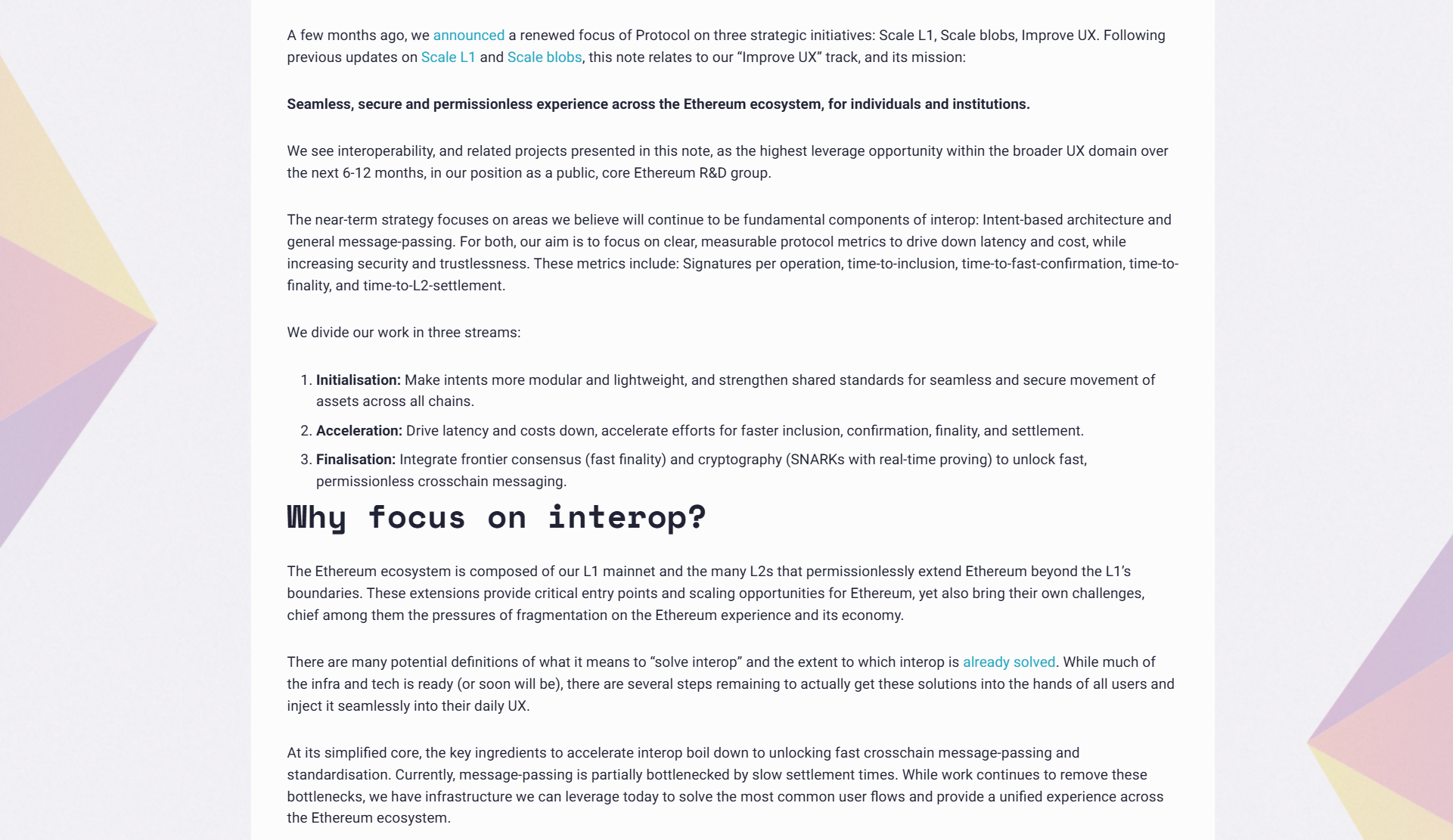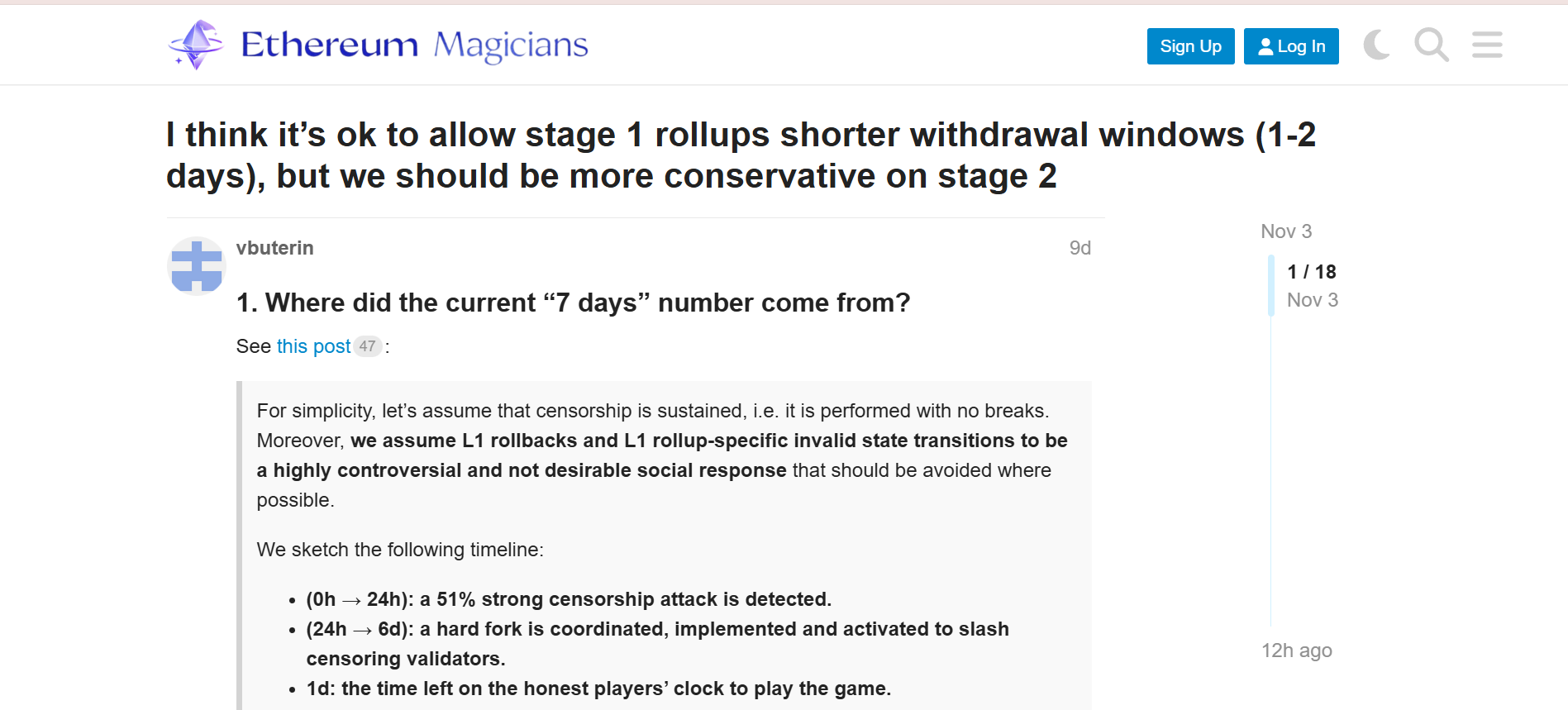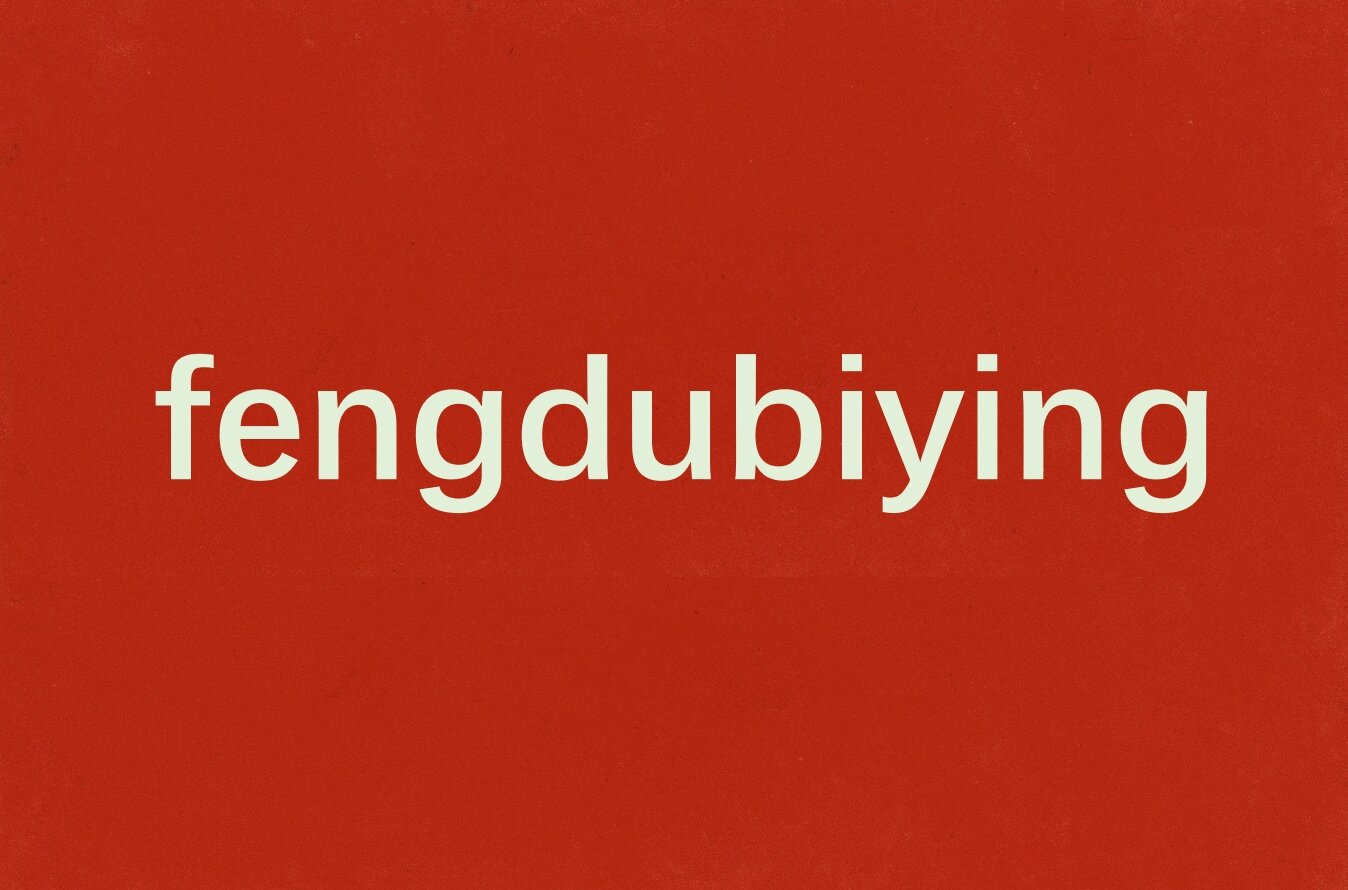Ethereum Interop Roadmap: How to Unlock the "Last Mile" to Mass Adoption
In the Web3 world, from "cross-chain" to interoperability, it has always been an evergreen narrative.
Of course, many people may not strictly distinguish the connotations of the two. If we were to summarize it in one sentence, cross-chain focuses more on assets and mainly solves the problem of "transfer"; while interoperability covers multiple dimensions such as assets, state, and services, and aims to solve the problem of "collaboration".
In fact, as modular narratives have increased the number and heterogeneity of L1/L2, users and liquidity have been further dispersed. Interoperability has been recognized as a more ideal end-game than cross-chain – users no longer need to be aware of which chain they are on, they only need to submit an intent once, and the system will automatically complete the operation in the most suitable execution environment.
With the recent announcement of a new UX roadmap by the Ethereum Foundation (EF), and a series of engineering advancements surrounding withdrawal latency, messaging, and real-time proofs, the interoperability puzzle is being pieced together systematically.
1. What exactly is "Interop"?
Simply put, "interoperability" is far more than just an "asset bridge"; it's a combination of a whole set of system-level capabilities.
This means that different chains can share state and proof, smart contracts can call each other's logic, users can get a unified interactive experience, and all execution environments maintain equal trustworthiness at security boundaries.
When these capabilities are met simultaneously, users can truly focus on the value activity itself, without being bothered by network switching, duplicate authorization, or liquidity fragmentation. This also echoes the ultimate goal of cross-chain engineering: to allow users to focus on the flow of value itself, rather than the barriers between chains (further reading: " The Evolution of Cross-Chain Engineering: From 'Aggregation Bridge' to 'Atomic Interoperability,' What Future Are We Heading To? ").
Especially after entering 2024, modular narratives entered a period of full-scale explosion, with more and more fragmented L1 and L2 layers appearing, making interoperability no longer just high-level talk at the protocol layer, but beginning to truly sink into the user experience and underlying application logic of the general public.
Whether it's an intent-centric execution architecture or new applications like cross-chain aggregation and full-chain DEX, they all explore the same goal: to allow users and liquidity to no longer be limited to the Ethereum mainnet, nor to frequently switch networks, but to complete on-chain asset exchange, liquidity provision, and strategy operations in a unified interface and in one stop.
In other words, the ultimate potential of interoperability lies in completely removing blockchain from the user's viewpoint—allowing DApps and project teams to return to a user-centric product paradigm, creating a low-barrier environment that is easy to use and provides an experience close to Web2, and removing the last obstacle for users outside the blockchain to seamlessly enter the Web3 world.
After all, from a product perspective, the key to mainstream adoption is not to make everyone understand blockchain, but to enable them to use it without needing to understand it. It can be said that if Web3 is to reach billions of people, interoperability is the infrastructure for that "last mile".
Back on August 29, the Ethereum Foundation released "Protocol Update 003 — Improve UX". This article continued the three major strategic directions of EF after reorganizing the R&D team this year: Scale L1 (mainnet scaling), Scale Blobs (data scaling), and Improve UX (improving user experience).
And the core theme of "Improve UX" is interoperability.

Source: Ethereum Foundation
II. From "Cross-chain" to "Interoperability": Signals Released by EF
This EF article emphasizes interoperability as the core, with the goal of a seamless, secure, and permissionless Ethereum ecosystem experience. The main point can be summarized in one sentence: cross-chain asset transfer is only the first step; cross-chain collaboration of data, state, and services is the true meaning of "interoperability." In the future, Ethereum plans to make all Rollups and L2 "look like one chain."
Of course, EF also admits that although most of the infrastructure and technology are mature (or about to mature), several key engineering implementation steps are still needed to truly deliver these solutions to users and integrate them naturally into the daily experience of wallets and DApps.
Therefore, EF splits the development of "Improve UX / Interop" into three parallel main lines: Initialization, Acceleration, and Finalization.
The first step is "initialization," with the goal of becoming the starting point for interoperability, making Ethereum's cross-chain behavior lighter and more standardized.
The core work includes making Intents lighter and more modular, establishing common standards, bridging the path between cross-chain assets and cross-chain operations, and providing replaceable and composable common interfaces for different execution layers.
Specific projects that have been implemented include:
- Open Intents Framework (OIF): A modular intent stack, jointly built by EF, Across, Arbitrum, Hyperlane, LI.FI, OpenZeppelin, and others, supporting the free combination of different trust models and security assumptions;
- Ethereum Interoperability Layer (EIL): Led by the ERC-4337 team, it builds a permissionless, censorship-resistant cross-L2 transaction transport layer, making multi-chain transactions as natural as on a single chain;
- A new set of standards (ERC series): covering interoperable addresses (ERC-7828/7930), asset consolidation (ERC-7811), multiple calls (ERC-5792), intent and general messaging interfaces (ERC-7683/7786);
The goal is straightforward: to decouple "what users want to do" (declarative) from "how the system executes it" (procedural) and enable wallets, bridges, and verification backends to collaborate under a unified semantic framework.
The second step is "Acceleration," which reduces latency and costs, making multi-chain operations more real-time.
Specifically, the reduction in time and cost revolves around measurable indicators such as "signature count, inclusion time, fast confirmation, finality, and L2 settlement." The key measures include L1 fast confirmation rules (bringing strong confirmation to the 15-30 second range), shortening L1 slot time (research and engineering groundwork for reducing it from 12 seconds to 6 seconds), and shortening the L2 settlement/withdrawal window (adjusting the optimistic 7 days to 1-2 days, or introducing ZK proof and 2-of-3 fast settlement mechanism). These measures are essentially laying the foundation for cross-domain message passing and a unified experience.
Ultimately, the "final determination" step involves combining real-time SNARK proofs with faster L1 finality to explore interoperability models with second-level finality. In the long run, this will redraw the landscape of cross-domain issuance, bridging primitives, and cross-chain programmability.
Objectively speaking, in the Ethereum context, Interop is no longer limited to the concept of an "asset bridge," but rather a collective term for a whole set of system-level capabilities:
- Cross-chain data communication —different L2s can share state or verification results;
- Cross-chain logic execution —one contract can call the logic of another L2;
- Cross-chain user experience – users only see one wallet and one transaction, instead of multiple chains;
- Cross-chain security and consensus – maintaining the same security boundary across different L2 blockchains through proof-based systems;
From this perspective, Interop can be understood as the common language among future Ethereum ecosystem protocols. Its significance lies not only in the transmission of value, but also in the sharing of logic.
III. How does Ethereum pave the way for "interoperability"?
It is worth noting that Vitalik recently initiated a discussion on the Ethereum Magicians forum about shortening the Stage-1 optimistic aggregation withdrawal time, advocating for reducing the withdrawal cycle from the traditional 7 days to 1-2 days, and proposing to gradually introduce a faster settlement and confirmation mechanism under the premise of controllable security.
This discussion, ostensibly related to Rollup's withdrawal experience, is actually a direct response to one of the three major directions of "interoperability"—acceleration.

Source: Ethereum Magicians
After all, withdrawal delays are not just a user experience issue of waiting too long, but a liquidity bottleneck in the entire multi-chain collaboration system:
- For users, it determines how quickly funds flow between different rollups;
- For intent protocols and bridge networks, it affects the capital efficiency of the solution;
- For the Ethereum mainnet, it determines whether the ecosystem can maintain consistency and security amidst higher-frequency interactions;
Vitalik's view is essentially opening the floodgates for this. In short, shortening withdrawal time not only improves the user experience of Rollups, but also unlocks the infrastructure upgrade for cross-domain messaging, liquidity, and rapid state transfer. This direction is also completely consistent with EF's goal in the "Acceleration" main line, which is to shorten confirmation time, increase settlement speed, reduce in-transit funding costs, and ultimately make cross-chain communication real-time, reliable, and composable.
These efforts will align with the Devconnect event held in Argentina on November 17th. According to the official agenda, Interop will be one of the key themes of this year's Devconnect, and the EF team will also announce more details related to EIL (Ethereum Interoperability Layer) at the event.
Overall, it all points in the same direction— Ethereum is completing its transformation from "scaling" to "integration".
Of course, this article, as the first in the Interop series, only raises the fundamental question that interoperability is the ultimate goal of cross-chain narratives, and provides a preliminary glimpse into the current structural upgrade of the Ethereum ecosystem, from EF's technical roadmap to Vitalik's real-time discussions, from standardized engineering layouts to gradually shortening settlement cycles.
We will continue to explore from different perspectives why interoperability is not just a bridge, but also the underlying protocol connecting the future of Ethereum.
Stay tuned.
- 核心观点:互操作是跨链叙事的终极形态。
- 关键要素:
- 以太坊基金会将互操作定为核心战略。
- 聚焦初始化、加速、最终确定三阶段。
- 缩短提款时间提升流动性效率。
- 市场影响:推动多链无缝协作,提升用户体验。
- 时效性标注:中期影响。



